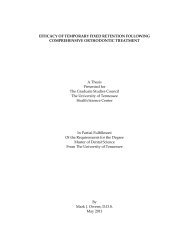BEVACIZUMAB EFFECT ON TOPOTECAN PHARMACOKINETICS ...
BEVACIZUMAB EFFECT ON TOPOTECAN PHARMACOKINETICS ...
BEVACIZUMAB EFFECT ON TOPOTECAN PHARMACOKINETICS ...
You also want an ePaper? Increase the reach of your titles
YUMPU automatically turns print PDFs into web optimized ePapers that Google loves.
hypertension and the pathologic extracellular matrix [19-21]. The major role of lymphatic<br />
vessels is to drain the interstitial fluid from peripheral tissue to blood vessels and to<br />
maintain the interstitial fluid balance in the tissue [19]. The rapid proliferation of tumor<br />
cells compresses blood vessels and lymphatic vessels [17]. Accordingly, the lymphatic<br />
system inside the solid tumors becomes dysfunctional and the blood vessels become<br />
structurally and functionally abnormal [4-6, 11, 14-18]. However, there are functional<br />
lymphatic vessels in the margin of the solid tumors or in the peri-tumor tissues [1]. Thus,<br />
the interstitial fluid is confined within solid tumors, and interstitial fluid pressure is<br />
uniformly high throughout the core of a solid tumor, while dropping dramatically in the<br />
tumor margin [22, 23]. The extracellular matrix (ECM) consists of basement membrane<br />
and interstitial stroma. The basement membrane mainly contains collagen IV, laminin<br />
and proteoglycans, while the interstitial stroma mainly contains fibrillar collagens,<br />
fibronectin, hyaluronic acid, and fibril-associated proteoglycans [24]. In solid tumors, the<br />
components in ECM are dynamically changed and large amount of these components are<br />
overexpressed, attributable in part to the extensive synthesis of ECM [25-27].<br />
Furthermore, the fast growth of tumor cells within a limited space also squeezes or<br />
compresses the ECM into a compacted pattern [28, 29].<br />
The third hallmark of solid tumors─the unfavorable solid tumor metabolic<br />
environment─is the low levels of oxygen and acidic pH [30-32]. Due to an imbalance<br />
between tumor cell proliferation and vasculature development, multiple regions of cells<br />
in solid tumors are distant, such as 180 µm away from blood vessels, so that oxygen<br />
cannot be transported and diffused to those regions [33, 34]. This chronic effect of<br />
hypoxia results in multiple necrotic regions in solid tumors. Even though the tumor cells<br />
are close to the blood vessels, they can also undergo acute hypoxia due to the intermittent<br />
and irregular blood flow [35]. The low extracellular pH is due to increased production<br />
and reduced removal of H + ions [1]. The main sources of increased H + ions production<br />
are from anaerobic glycolysis under the hypoxia condition and from CO 2 and H 2 O by<br />
carbonic anhydrase [36]. The reduced removal of H + ions is caused by abnormal<br />
microcirculation.<br />
In conclusion, the microenvironment in solid tumors displays an aberrant vascular<br />
compartment, a compacted extra-vascular compartment, and unfavorable metabolic<br />
environment.<br />
1.1.2 Determinants for drug penetration in solid tumors<br />
After reaching the systemic circulation, therapeutic drugs quickly diffuse through<br />
the vasculature and distribute within the solid tumors. Drug penetration in solid tumors<br />
depends on several factors, including the physicochemical properties of the drug,<br />
formulation, and the delivery system of the drug as well as the neoplastic tissue<br />
microenvironment. For a formulated drug product, there are three major determinants or<br />
barriers in solid tumors that inhibit drug penetration from systemic blood circulation to<br />
the therapeutic target cells: the aberrant blood vessel architecture, the heterogeneous<br />
vessels’ wall, and the compacted extracellular matrix [37].<br />
2
















